For the diver wishing to fine-tune their trim and overall diving experience, a BCD is the next logical purchase. The variety of options on the market can make BCD selection seem somewhat overwhelming, especially as so many look the same as the next. However, there are some basic factors to look for in all BCDs, including but not limited to: lift capacity, storage capacity, bladder position and type, and weight integration. Hopefully, our buyers advice guide and product recommendations will help to simplify this process for you and help you pick the best scuba diving bcd.
Best Scuba Diving BCD’s Reviewed
#1 – Apeks Black Ice BCD
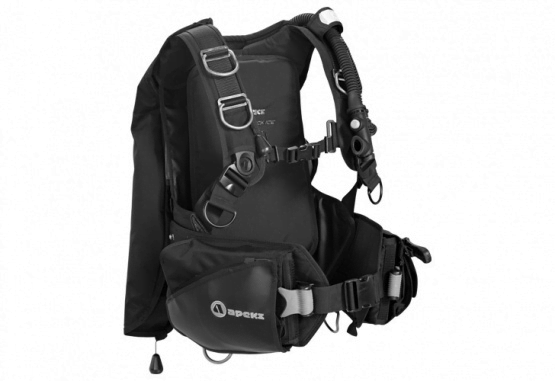
In the words of Apeks themselves, this is a BCD designed with the ‘advanced diver in mind.’ This is a BCD suitable for the extremity of public safety diving, as well as for normal recreational diving. Its size is fully adjustable so that it can be tailored to your exact shape. This is a BCD that will not let you down.
Features
- Weight-integrated back inflation jacket style BCD.
- Ditchable dual channel weight pockets as well as non-ditchable trim weight pockets in back – capable of carrying up to 19kg total.
- SureLock II Mechanical Weight Release System – easy insertion and removal of weight pockets.
- Four dump valves – two tail valves, one shoulder valve, and Powerline inflator/deflator.
- Powerline inflator has very quick inflation rate, with environmental seal. Comes with integrated clips to keep the LPI hose streamlined.
- Two zip operated pockets – left has a deep capacity, extendable pocket.
- Height-adjustable chest strap to avoid it running over the top of the drysuit inflation valve.
- Knife attachment with grommets found on left pocket – this accommodates AquaLung squeeze-lock knives.
- Dual bladder retraction system to prevent excess drag.
- Able to be rigged for a twinset configuration.
- Uses the Wrapture Harness System – the Wrapture prevents ‘ride-up’ when on the surface, as well as keeping the tank in line with your centre of gravity by placing the weight on the hips when out of the water. This is achieved by use of swivelling shoulder strap buckles as well as the ultra-thin back plate.
- Air cell allows easy movement of air from side to side, and is constructed from 840 denier nylon.
- 3 shoulder D-rings and 2 angled tail D-rings.
Drawbacks
- Big, bulky, and heavy – not ideal for travel.
#2 – XDeep Zen BCD
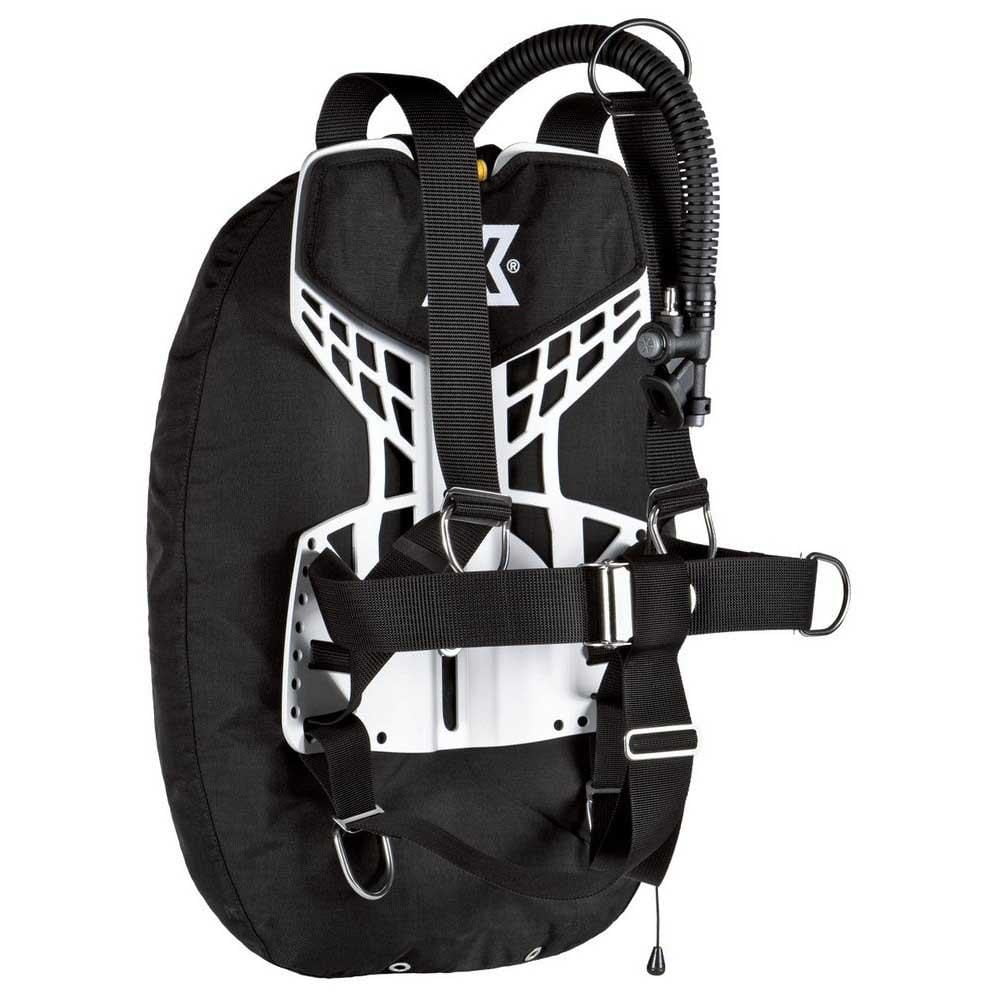
Building on previous designs, the XDeep Zen BCD is one of the best options on the market for recreational divers. Utilising a simple, minimalistic design, whilst not compromising on comfort nor performance, XDeep have come up with an excellent BCD. It is also perfect for travel, weighing a mere 1.1kg.
Features
- K-Type inflator.
- Dry BCD weight (without harness): 1.1 kg
- Anatomically sculptured back plate for maximum comfort and optimum weight distribution.
- Mesh pad on backplate to add comfort and reduce slippage.
- Easier donning and doffing – shoulder straps gain 20% increase in length when crotch and waist band are undone.
- V-shaped crotch strap – greater comfort than standard single strap design.
- Weight pockets can be added at the user’s will.
- Optional shoulder strap padding.
- Optional shoulder strap quick-release clips.
- 5 D-rings: 2 shoulder, 2 tail, 1 on left hip.
- CORDURA® 1100 dTEX.
- Lift capacity: 19kg.
- Minimalistic design.
- Air cell has minimal air migration, and is streamlined to the tank, minimising drag.
- All-in-one package (Backplate, harness and wing).
Drawbacks
- Slightly high price.
#3 – AquaLung Zuma BCD
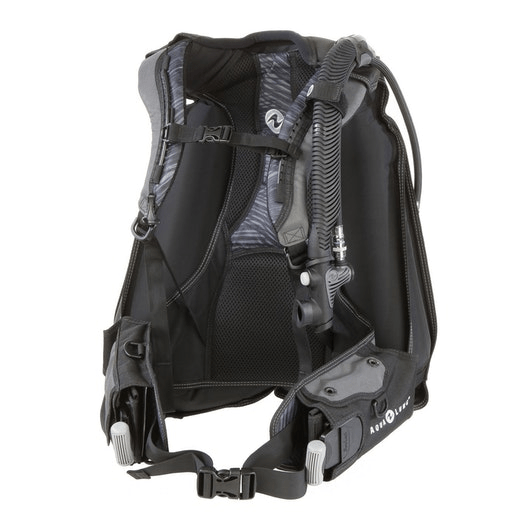
Features
- Streamlined, travel-friendly, weight-integrated back inflation jacket style BCD.
- Less than 2.2kg total weight.
- Padded spinal column protecting the user from tank weight.
- Weight emphasis shifted to hips due to lower tank strap position.
- SureLock II Mechanical Weight Release System.
- Ditchable, quick-release weight pockets.
- Can be deconstructed and rolled up to fit in very small spaces in luggage.
- Drop down utility pocket with deep capacity.
- Powerline inflator.
- Plastic D-rings in place of metal ones for weight reduction.
- Rolled collar for comfort.
- Flat, streamlined dump valves for reduced bulk.
- 4 D-rings: 2 shoulder, 2 on top of waist pockets.
- Adjustable chest strap.
- Very affordable price.
Drawbacks
- Lack of storage capacity – pockets are small, D-rings have a small circumference.
- No tail D-rings.
- D-rings are plastic, not metal – less durable.
#4 – OMS BCD
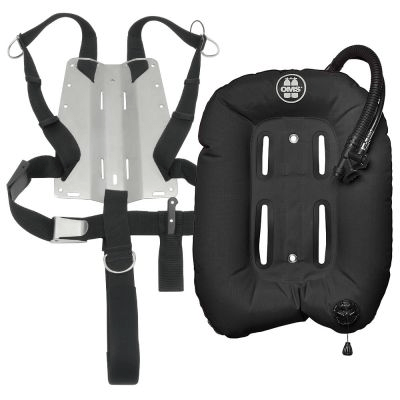
OMS are a trusted company, supplying divers with equipment for some of the most demanding of dives. Their Monowing, Backplate and Harness package, as sold exclusively by Divegearexpress.com offers a great BCD system for a very reasonable price, saving you the hassle of buying each item individually.
Features
- Hogarthian (DIR) configuration
- Heavy duty nylon continuous webbing harness
- Metal backplate available in stainless steel or aluminium
- Waist belt sheath with knife and shears included
- Wing available in different sizes with differing lift capacities – 12kg or 15kg lift.
- Optional shoulder pads and weight pockets.
- All-in-one package (Backplate, harness and wing).
#5 – AquaLung Axiom BCD
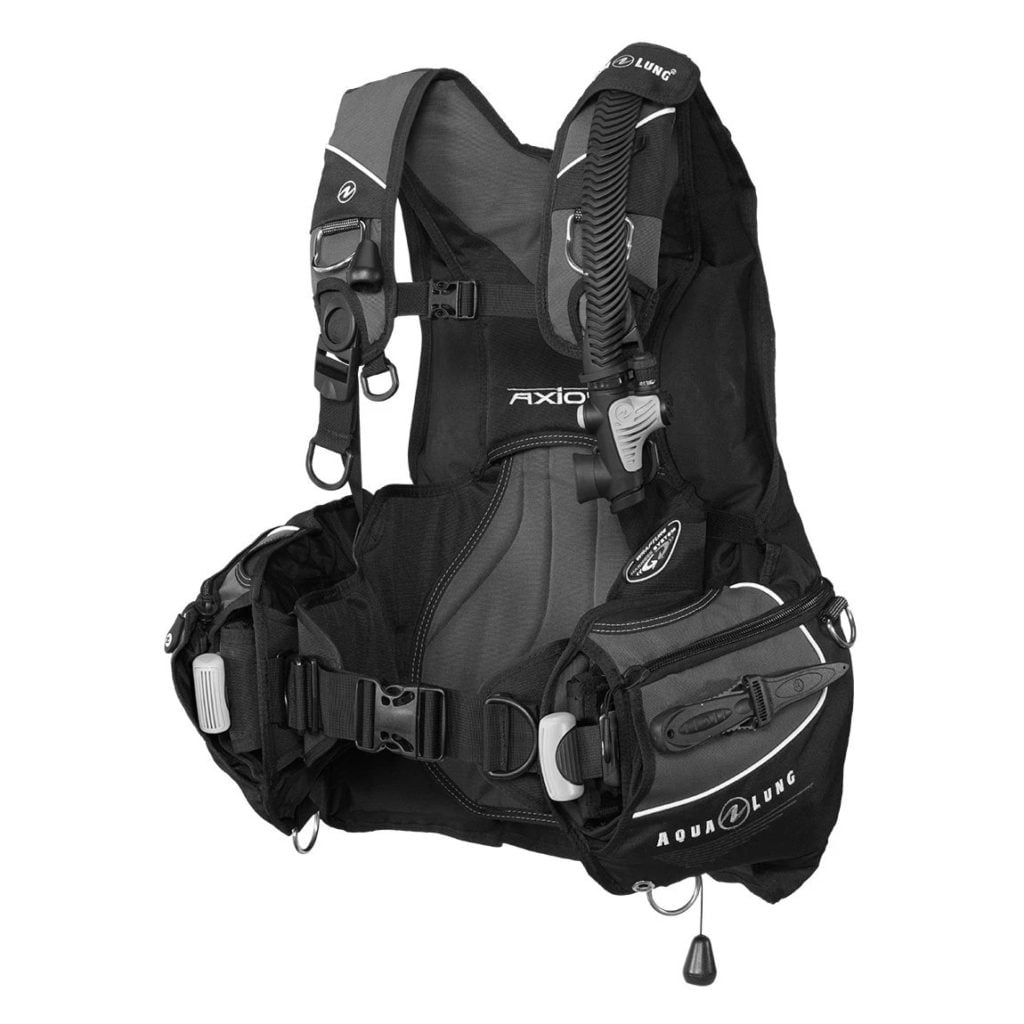
AquaLung’s Axiom is a BCD favoured by many divers. It is very robust and reliable, and offers the diver a host of storage options without compromising comfort. This is a great option for divers who prefer a traditional wrap around, jacket style BCD.
Features
- SureLock II Mechanical Weight Release System – easy insertion and removal of weight pockets.
- Powerline inflator has very quick inflation rate, with environmental seal. Comes with integrated clips to keep the LPI hose streamlined.
- Two large zip operated pockets.
- Uses the Wrapture Harness System – the Wrapture prevents ‘ride-up’ when on the surface, as well as keeping the tank in line with your centre of gravity by placing the weight on the hips when out of the water.
- Swivelling shoulder strap buckles.
- GripLock tank band.
- Bladder retraction system.
- Rolled collar for comfort.
- 6 D-rings: 2 shoulder, 2 waist, 2 tail.
- 3 dump valves: 2 shoulder, 1 tail.
- Knife attachment point with grommets for AquaLung squeeze-lock knives.
- Dedicated alternate air source holster pocket.
Drawbacks
- Is not a purely back inflate BCD; perfect trim is harder to achieve and maintain.
- Big, bulky and heavy – not ideal for travel.
#6 – Apeks WTX30 PSD BP/W BCD
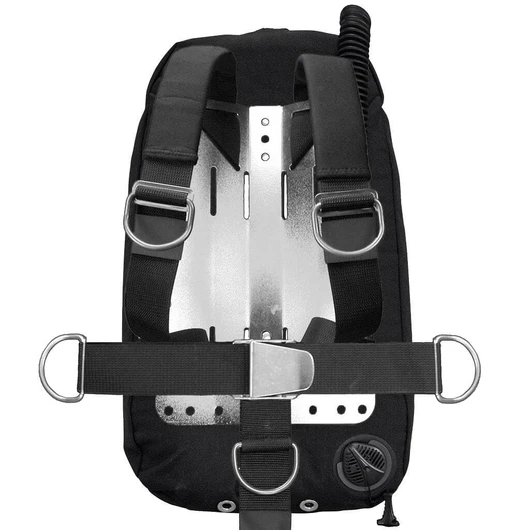
Apeks’ WTX30 PSD wing with harness and backplate is a great option for divers who are looking for a minimalistic rig with extreme durability. The PSD wing is designed for public safety diving use (hence the acronym!) and is therefore made of a very tough material; Armourguard. This means that the wing is capable of performing in all environments with minimal wear-and-tear. This BCD is an excellent option for divers of all levels.
Features
- Minimalistic, robust harness design.
- 5 D-rings: 2 shoulder, 2 hip, 1 crotch.
- Backplate available in either aluminium, stainless steel, or Apeks’ travel hybrid.
- Wing made from Armourguard: more resistant than cordura, faster drying, anti-bacterial.
- K-Type inflator.
- Optional Surelock II weight system.
- 13kg lift capacity.
Drawbacks
- Slightly high price.
Choosing your First BCD: Product Recommendations and Buyers Advice
Scuba Diving BCD Basics
The acronym BCD, or BC, stands for Buoyancy Control Device, or Buoyancy Compensator, respectively. And, with this definition in mind, the term BCD encompasses all devices with an air bladder designed to affect a diver’s buoyancy. Therefore, BCDs include jacket style BCDs, backplate and wing BCDs, sidemount BCDs, and even no-mount BCDs for use on tanks. However, for the purposes of this article, we are talking strictly about BCDs for single-tank recreational back mount diving.
There are, generally speaking, three styles of BCDs on the market:
- Jacket-style
- Back-inflation jacket-style
- Backplate, harness and wing (BP/W)
It is a likely bet that your first taste of scuba occurred wearing either a jacket-style or back-inflation jacket style BCD. These are the most common types of BCDs, especially the former, and are stocked at the majority of dive centres for customer and student rental. A backplate, harness and wing setup, on the other hand, is less common. The reason for this is not due to an inferiority of the latter; far from it. Rather, the BP/W setup is often associated as solely the preserve of those engaged in technical diving. This is a widespread fallacy which will hopefully be dispelled over the course of this article.
Jacket Style BCDs
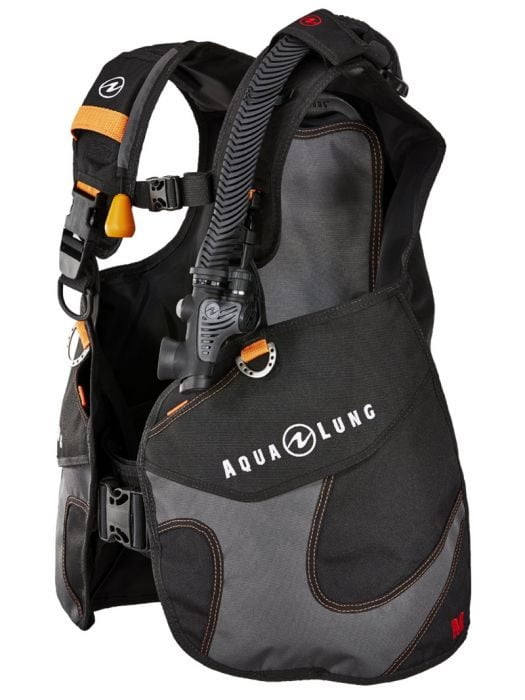
As the name suggests, a jacket-style BCD is essentially a sleeveless jacket. Most of the time, it comes with a chest strap, quick-release shoulder buckles, a stomach buckle, and a velcro cummerbund. The majority of clips and hard-structure parts are composed of plastic. In a jacket-style BCD the bladder, or air cell, encompasses the whole back and wraps around the waist of the diver underneath the armpits (sometimes referred to as a ‘wrap around’ BCD). This means that, on inflation, air is able to migrate to every portion of the jacket. Similarly, they often come with a lot of extra padding features to increase comfort. It is probable that this is what you were given to use during your Open Water course.
The jacket-style BCD is simple in construction, and is fairly easy and intuitive to don and doff without guidance. Consequently, they have become commonplace within the scuba industry. And it is true; they are easy to use, and require no special techniques for donning and doffing. They also usually come with numerous pockets and D-rings, as well as with the ability to integrate weights into the jacket itself, rather than having to wear them on an external weight belt.
However, it is indisputable that traditional jacket-style BCDs come with a range of drawbacks. Firstly, is the issue of trim. The jacket-style BCD tends to allow air to build up around the shoulder region, as well as allowing it to shift continuously from one side of the back to the other. This results in two things. Firsty, this forces the diver into a more pronounced head-up legs-down position which, in the worst case, puts the diver on a vertical plane. Secondly, it will mean that the diver is likely to be constantly rolling to one side, calling for continual readjustment to become level again. This is not to say that perfect trim (20-40° off horizontal) cannot be achieved in a jacket-style BCD; it certainly can be, and – ultimately – the quality of your trim is dependent on your skills as a diver, not your equipment. However, even if you can achieve perfect/near-perfect trim in a jacket-style BCD, you will be in a constant battle of readjustment and movement in order to maintain it. Due to its construction, the jacket-style BCD naturally wants to put your body into the vertical plane.
A second drawback of jacket-style BCDs is their lack of customizability. When compared to a BP/W (as will be seen later), a jacket-style BCD is very limiting. You are unable to move any of the D-rings, unable to move/add/or subtract pockets, unable (in most cases) to fully deconstruct it. In essence, you cannot get ‘under the bonnet’ of a jacket-style BCD. Therefore, you are unable to personalise it to both your physical needs as well as your diving needs. Similarly, unlike a BP/W, a jacket-style BCD lacks versatility; it can be used only for single tank back mount diving. Conversely, a BP/W can be used for single tank back mount, twinset and multistage diving, with only minor adjustments (swapping out of the wing). Considering the cost of some top of the range jacket-style BCDs, this is a limiting purchase for the diver in the long run.
A third disadvantage of jacket-style BCDs is their inherent bulkiness. As the majority of them are unable to be deconstructed, as well as having lots of extra padding, this makes for a large, relatively heavy piece of luggage. With a BP/W, and even with some back-inflation travel specific jacket-style BCDs, this problem is avoided – or at least minimised – by the fact that full deconstruction is permitted, allowing the air bladder to be rolled up. This makes for a much better option for the travelling diver.
Backplate, Harness and Wing BCD (BP/W)
The BP/W setup was the original equipment setup. In the early days of diving, divers would simply strap a harness to their twinset, with neither a wing nor backplate. However, they suffered issues of tank roll, due to the fact that the tanks were not fixed to anything. Thus came the advent of the backplate. With Floridean cave divers increasing their penetration depths and runtimes came a need to carry more tanks. This led cave divers to look for ways to outsource positive buoyancy. The initial attempts came in the form of rigging hydration bladders to the harness, and inflating them orally. Over time, came the development of the first ‘wing’; simply, an inflatable air cell to be attached to the backplate. With the concurrent popularisation of diving, manufacturers took this wing design and came up with the jacket-style BCD, adding quick-release buckles and adjustable shoulder straps too. The cave diving community did not, however, adopt the jacket-style BCD, due to its bulkiness; which posed a problem for both tight restrictions as well as for the handling of multiple stage bottles. And so, the BP/W setup became the preserve of cave and technical divers, whilst the jacket-style BCD became that of recreational divers.
A BP/W setup is very simple. It consists of three elements: the harness, the backplate and the wing, all of which can be detached from one another.
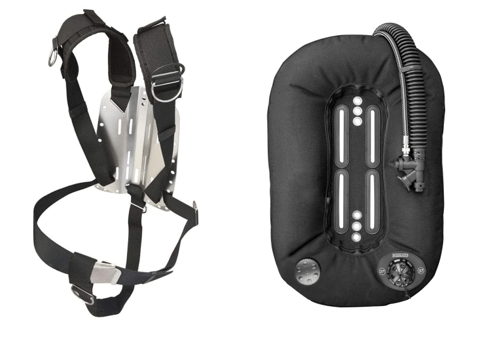
The first benefit of this setup is that it is fully customisable.
The webbing that composes the harness can be interchanged for one that is either stiffer or softer depending on diver preference. Similarly, D-rings are able to be moved, added and subtracted. If you find the shoulder D-ring too high when trying to clip your torch to it, you can simply move the D-ring further down the shoulder strap, for example. There are many different types of D-rings on the market, in different sizes with different designs; some are angled, some flat, some fixed, some sliding. If you require extra attachment points, then you can just add them yourself, be it on the shoulder straps, the waist belt, or the crotch strap.
The backplate can also be customised to your needs. They are available in either stainless steel or aluminium (and, in rare cases, in titanium or carbon fiber). This means that if keeping your luggage weight down is a real concern as a travelling diver, then you are able to do so by buying a lighter, aluminium backplate. Equally, if you are diving in a drysuit in your local quarry, then investing in a steel backplate will be a better decision to reduce the amount of extra weight required. The beauty of this setup is in the fact that you can buy both a steel and an aluminium backplate, and interchange them depending on your diving needs. Similarly, different companies come with differently moulded backplates, accommodating different body shapes and needs. You can also add or subtract padding based on personal preference.
Following suit of its siblings, the wing can be interchanged based on the lift capacity required. If diving with only one tank, then a single tank wing is required; with a twinset, a double tank wing is required. The difference in size and lift is substantial: a single tank wing is expected to lift one tank and perhaps one stage; a double tank wing is expected to lift up to five tanks (twinset plus three stages). What is great is that if you are moving from single tank recreational diving into twinset technical diving, you need simply to purchase a new wing, rather than replacing the whole system. Similarly, if you were going on a diving holiday, involving both technical and recreational dives, you can just bring a single wing and double wing, rather than a twinset BP/W setup in addition to a separate jacket-style BCD – thus saving you substantial luggage space and weight.
The second benefit of the BP/W setup is that of trim. Given that the air cell is only on the back, in either donut or horseshoe shape, without unnecessary bulk on the diver’s front, the wing is able to place the diver in a position of perfect trim far more easily. Air will not migrate without the diver actively making it do so. This makes the achievement and maintenance of perfect trim far easier; though diver skill is still a prerequisite.
The third benefit of the BP/W setup is the fact that it is minimalistic. It declutters the diver from excess material, leaving them with the bare essentials required to dive. This gives the diver a very liberating feeling, cutting out that which is inessential. For many, the switch from a jacket-style BCD to a BP/W setup is a turning point in their diving ability and, therefore, experience. It is akin to becoming one with the underwater environment.
Back-Inflation Jacket-Style BCDs
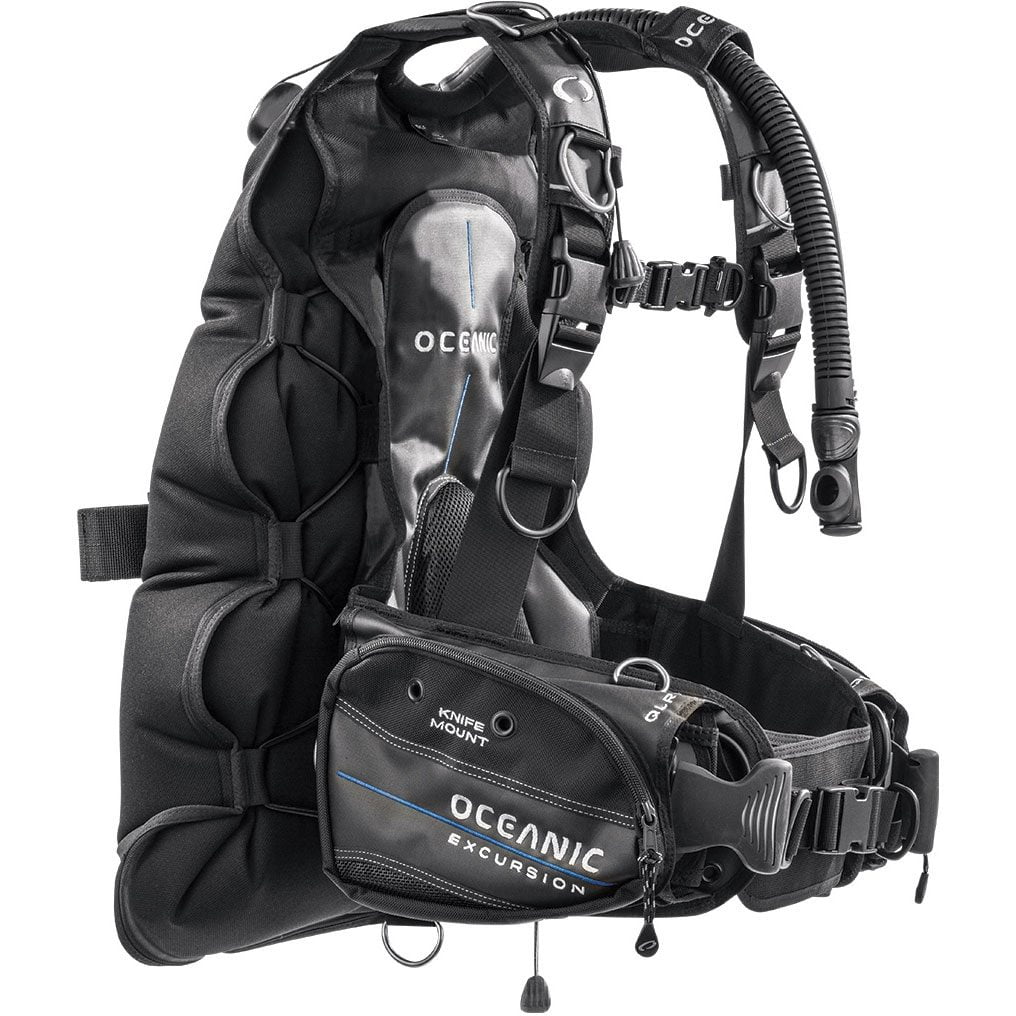
The semidry of BCDs, the back-inflation jacket-style offers something of a compromise. And, as with most dive equipment, its name implies its function. A back-inflation jacket-style BCD is a jacket BCD in which the air cell is only on the back of the jacket – like a wing. This allows perfect trim to be achieved more easily, like that of a wing, without losing the feeling that accompanies the jacket. This is a great option for divers wanting greater buoyancy and trim control without making the full conversion to the BP/W setup.
Misconceptions
Although BP/W setups are becoming increasingly popular in the recreational diving community, there are still many divers who – for various reasons – resist their rise. There are numerous misconceptions surrounding BP/Ws which will now be addressed. Of course, this is not to say that you are wrong to dive in a jacket-style BCD. Jacket-style BCDs are fantastic and offer a very easy, simple device with which to dive with. However, BP/W BCDs are also just as easy and simple to dive with. Similarly, from the perspective of equipment optimisation, streamlining, versatility and trim, BP/W setups are inarguably the best choice.
One of the primary misconceptions stems from the fact that BP/W setups are used mostly by technical divers. This, by implication, has led people to assume that they require advanced skills in order to be used correctly. And this itself implies that BP/W setups are not for beginners. This could not be further from the truth. Yes, jacket style BCDs are fairly intuitive to use, and are therefore an easy option to give to a beginner. However, the BP/W setup is no more difficult nor less intuitive once the proper techniques for donning and doffing are explained by the instructor. In fact, once this is made clear, the beginner diver will have much more ease achieving and maintaining proper trim. There are many instructors from multiple training agencies who teach their Open Water students in a BP/W setup from the outset. Similarly, DIR training agencies, such as GUE and ISE, teach their recreational courses solely in a BP/W setup. Once the fundamentals of donning, doffing and adjustment are made clear, the BP/W setup is ideal for a beginner diver getting to grips with buoyancy and trim.
A second misconception remains in circulation regarding BP/W setups. That is that they do not afford the storage capacity offered by their counterpart. This is, once again, a fallacy. As a matter of fact, it is arguable that the BP/W setup offers greater storage capacity. A standard jacket-style BCD usually has two waist pockets and between 2-5 D-rings. A BP/W setup, on the other hand, can have pockets and D-rings added at the will of the diver. If the diver wished for 5 D-rings per side of the waist belt, and 3 per shoulder strap, such would be possible. Similarly, the diver can add multiple pockets, with the specific capacity they require, wherever they like on the harness. The backplate also often has holes in it which fit the gate of a boltsnap, allowing for additional attachment points that are out of the way. In addition, many BP/W divers like to invest in ‘technical shorts’ which are worn over the wetsuit, with two large cargo pockets either side of the thigh. This allows for the BP/W to be kept free of excess equipment, enabling the feeling of freedom to be maximised. Although it may be argued that these are additional costs to the initial purchase of the BP/W, they are often inexpensive additions which can be fully customised to the diver’s needs. An equal benefit of this is that, if one of the component parts break, they are easy to replace and don’t require the whole BCD to be replaced or sent away for fixing.
Another misconception is that of expense. BCDs are no different to other dive equipment in the sense that they are as expensive as you want to make them. Cheap BP/W BCDs are as cheap as cheap jacket-style BCDs, and the two can be just as expensive as each other. The point to make, however, is that the replacement parts (e.g. D-rings, webbing, backplates, etc.) are far cheaper, and fixes and modifications can be done by the diver. This cannot be done with a jacket-style BCD, often requiring it to be sent back to the manufacturer for fixing.